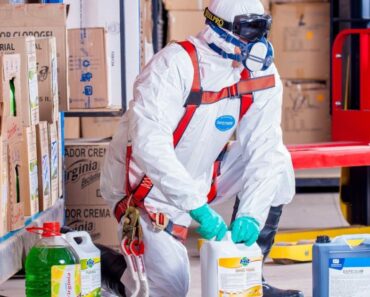Let’s face it. If it wasn’t for vaccines being used in the last 100 years, the human race would be constantly threatened by disease. Today, viruses that caused hundreds of thousands of people to die in the past now cause little to no harm to us. Our bodies have built up an immunity to them because of strong support for vaccination programs in the past.
Even with endless facts that vaccinations work, it will always be debated but here is an interesting comic that helps reinforce these facts. ‘Vaccines Work‘ is illustrated by the talented Maki Naro who is renowned for his work in Popular Science.















All illustrations by Maki Naro
Here is a transcript:
Vaccines Work: Here Are The Facts
Medical technology has advanced further in the last 100 years than it has throughout history.
We live our lives relatively disease-free…and we owe so much of that to vaccines.
Despite the overwhelming evidence, people still have questions and concerns. Which is okay.
In 1798, smallpox was killing hundreds of thousands of people every year. Until Edward Jenner noticed that milkmaids who had contracted cowpox, a less deadly form of the disease didn’t get smallpox. This was the first vaccine.
Vaccines are like a training exercise for your body. They use dead or damaged viruses to provoke an immune response, without having to get sick. From there, your body has time to develop the proper antibodies and form an immunity.
Since their implementation, smallpox has been eradicated, and diseases like polio, measles, mumps, and rubella are on their way out.
“If vaccines make me immune, why do I have to get a flu shot every year?”
Evolution is a constant arms race. As you become immune to invaders, the invaders adapt to try to get around your immunity. The flu is really good at this. Each year scientists have to try to predict which flu strain will be the big one to vaccinate against.
“I heard that vaccines cause autism.”
The myth began in 1998 when an English medical journal called The Lancet published a paper which claimed a link between autism and the Measles, Mumps, and Rubella vaccine (MMR).
However, after a lengthy investigation, it was discovered the author, Andrew Wakefield, and not only fudged the data…but also did a lot of other shady stuff. For example, he paid kids for blood samples at his son’s birthday party. Wakefield also had numerous conflicts of interest. Before publishing, he filed a patent for his own version of the MMR vaccine. He was paid hundreds of thousands of pounds by UK Legal Aid Fund for his expert testimony in a class action suit against MMR manufacturers. All of it undeclared.
Before long, celebrities like Jenny McCarthy began latching onto the scare.
Soon it became trendy to keep your children “pure” by not injecting them with “chemicals.”
By the time Wakefield’s misconduct had come to light, his paper retracted…and his medical license taken away…the damage was done. Now he is held up as a martyr by anti-vaccine proponents.
Scientists aren’t sure of the exact cause of autism, which is now understood to be a spectrum of developmental disorders…but none of them suspect vaccines. None.
“Somebody shared a list of vaccine ingredients and it sounds really scary!”
People are afraid of what they don’t understand. So a common tactic used by anti-vaccine proponents is to just list ingredients and let fear do the rest. For example: Initially, a preservative called thimerosal was attacked as the cause of autism. It’s an antifungal agent used to preserve multi-dose vials of vaccine. It also happens to have a mercury atom in it.
We’re taught that mercury is bad but it’s actually kind of complicated.
We forget that something we eat every day in every meal is made of two of the most volatile and deadly elements on earth. Sodium + Chlorine = Salt.
The mercury in thimerosal is ethyl mercury, which gets flushed out of the body. Unlike its brother, methyl mercury, which is the bad mercury. You know what has the bad mercury in it? Tuna.
In a well-meaning but ultimately harmful effort to appease the misinformed mobs, the CDC stopped using thimerosal in vaccines, even after an investigation found no link between it and autism.
The ones who truly suffer are people in developing nations who now have to pay more money to buy and maintain single-dose vials of needed vaccines.
Another chemistry fail is the calling of hydrochloric acid in vaccines. But if we remember back to our pH scale, acids can be added to an alkaline solution to make pH neutral. Which is exactly what they are doing there.
People also don’t understand that the difference between good and bad is about dosage. Even drinking too much water will kill you. In 2007, a woman died after drinking 6 liters of water in 3 hours.
The amount of scary sounding chemicals in a vaccine is well within FDA approved guidelines. Take formaldehyde, which is a natural metabolic byproduct. You’ve produced more in your body while reading this comic that you will ever get from a vaccine.
Finally, some of it is outright lies, propagated by websites with names like “vaccinetruth.org” or “the National Vaccine Information Center”.
“If they’re so wrong, why are there still people who are against vaccines?”
Ironically, the anti-vaccination movement is a lot like the pathogens that vaccines protect us against.
Their fear campaign is an ongoing arms race against facts. Each time science has proven them wrong…they simply change their stance to something else.
“Some people don’t want to vaccinate anymore. It’s their choice right?”
That’d only be true if their choice affected only themselves. An important benefit of vaccination is an effect called herd immunity.
If enough people are vaccinated against a disease (typically 83-85%), it has trouble spreading. This protects people who are not vaccinated, either because they are too young or have an allergy or other underlying medical condition.
In herd immunity, the vaccinated protect the unvaccinated.
As more and more people opt out vaccinating, the risk of outbreaks increases.
Some of those diseases that were on their way out are starting to come back.
These diseases were practically fairy tales in 2008 before the anti-vax movement. Now in 2014, the US is currently experiencing the worst measles and whooping cough outbreaks in decades.
“So, what ARE the risks of vaccines?”
The benefit/risk ratio of vaccines is one of the highest of any medical intervention out there. But, like any medical procedure, they carry some risks or potential side effects like redness, headache, or fever. Most of them are very mild.
The more serious reactions are incredibly rare. We’re talking one-in-a-million.
But people are bad at assessing risks. They drive without a seat belt out of fear that it will break their collarbone in an accident or blow their money on lottery tickets instead of putting it into savings!
H/t: 22 Words
What’s great about this cartoon/infographic is that Maki really hits home on so many points and hope that parents and other people do their research before jumping on the anti-vaccine bandwagon. Please share the reasons why vaccines work with your friends and family.



